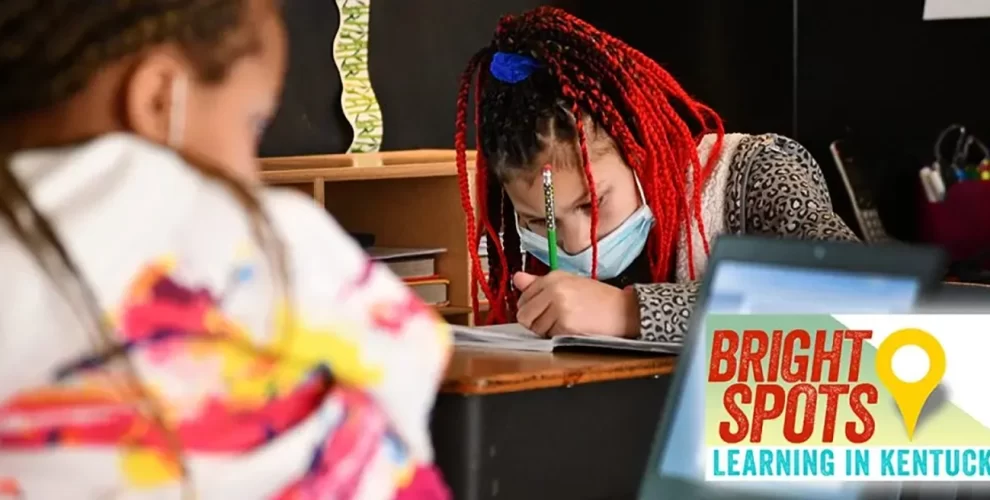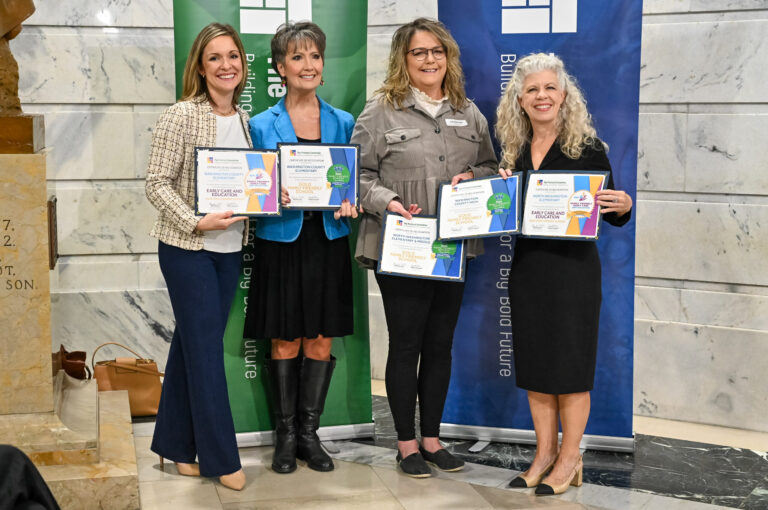AFTER A YEAR OF PANDEMIC, SCHOOLS SEE FRONTS FOR MOVING AHEAD

MARCH 2021 \ KENTUCKY ELEMENTARY SCHOOL VOICESOn the anniversary of the coronavirus abruptly upending in-person learning across Kentucky, leaders at some elementary schools making the strongest progress in creating student proficiency see a new landscape ahead as vaccines offer promise for a return to normalcy.Principals said it will take significant time and concentrated interventions to help many students catch up once five-day-a-week, in-person school resumes. They foresee that pandemic-mode education will also promote new productivity from technology advances; an increased emphasis on student and family engagement; extra options for learning and connection beyond traditional school days and hours, and a deeper appreciation for the power of collaborative work.“Schools will never look the same, now or when we return; and that’s not a bad thing,” said Jill Handley, principal of Kenwood Elementary in Louisville. Hybrid in-person learning resumed for the first time in mid-March for elementary students in the state’s largest school district and is scheduled to begin the first week of April for middle and high school students.Handley said that at her school, the year of remote learning has led to fundamental re-examination of schools’ connections with families, the importance of student engagement, teaching and learning fundamentals, support for teachers, and more. “We have much stronger relationships with families — we’ve been in their living rooms and they’ve been in teachers’ kitchens — which has helped us uncover needs we never knew and go beyond superficial connections.”Between the scramble to maintain links between schools and students that dominated the final weeks of last school year and the long planning for multiple scenarios in the current school year, Kenwood created a “family liaison teacher” position to support families and bridge the home-school connection. Continuing to navigate barriers to learning will be a long-term priority once normal routines can return and the school seeks to rebuild a stronger learning environment, Handley said.Kenwood has a track record for producing better-than-expected results. A study released late last year by the The Center for Business and Economic Research at the University of Kentucky and the Prichard Committee identified 47 such schools after examining eight years of recent academic results to find schools where outcomes significantly outpaced expected levels based on demographic factors. Math results got Kenwood on the list.At Glenn O. Swing Elementary in Covington, where three years of reading scores put it on the list, principal Sherry Lindberg said that connections with families and the community will be a greater asset after the pandemic, as will teachers’ new skills. “Our teachers have been phenomenal — and they’ve had to learn an entirely new way to teach.”A FOURTH GRADER AT GLENN O. SWING ELEMENTARY in Covington listens during teacher Karissa Storey’s reading class.The school had focused heavily on daily reading and writing work. (Read our 2018 Bright Spots profile.) The pandemic required a quick pivot to equipping students and families with technology that would allow learning to continue. Ensuring connections required months of work by the school, district, and city. That process also required teachers to change their approach and build new skills.“This is the hardest work we’ve ever done,” Lindberg said.At Hampton Elementary in Barbourville, principal Brian Frederick said that the mindset of “take the positives and roll,” has been a common theme for educators since the crisis disrupted schools last year. “When it comes to continuing to teach the academic standards, being responsive and being flexible, I have to say that my teachers are going to score off the charts,” he said. Hampton Elementary was recognized by the UK report because of reading achievement.Keeping students and families connected has been a huge challenge in rural areas like Knox County. Only two of Hampton’s 300 students are now unable to connect to the Internet from home because of their remote location, and the school has made arrangements to deliver video lessons and regularly pick up work from those families. Hampton returned to five-day-a-week instruction on March 8 after weeks on a hybrid calendar, which provided two days of in-school classes and online sessions the rest of the week.Looking toward a return to normal routines, Frederick agreed that schools will be poised to offer new ways for students and families to be connected to learning. Improved technology will drive improvements, he said. “The mindset now is that there’s more to a regular school day than just 8 to 3,” he said. “For some, the best time might be 7 at night.”
STRATEGIZING TO FILL GAPS
Beyond offering classes for students, Hampton teachers have continually met to go over student data and participation logs. Follow-ups and home visits helped to maintain involvement and progress, and the school continued to mail grades to spark a home focus on progress. Sessions for families at the school explained ways to monitor student progress and understand how online classrooms work.After the pandemic forced students and educators home last March, students were able to return for a part-time, hybrid classes at the school in October, but that was cut short as coronavirus cases escalated in the fall. The part-time classes resumed this spring followed by the current plan for everyday sessions.Frederick said he hopes that summer sessions, weekend classes, and other alternatives can help students catch-up as needed. He said that the federal Elementary and Secondary School Emergency Relief Fund, first passed by Congress last spring as part of the CARES Act stimulus program then added to a follow-up December stimulus appropriation has helped schools cope on many fronts. Kentucky received $193 million in the first round and then $928 million more, with 90 percent flowing to school districts.
Everyone else is going to be in the same shape we are — there are going to be deficits and we will have to find ways to get back on track.
— Hampton Elementary Principal Brian Frederick
At Hampton, the funds, along with local partnership with Internet providers, assured computers and online access for the 300 students at the P-6 school. “Technology really changed things,” Frederick said, adding that it should provide extra punch for interventions the school will put in place when regular routines are permanent and work can more fully turn to addressing areas where students are behind. “Everyone else is going to be in the same shape we are — there are going to be deficits and we will have to find ways to get back on track.”Frederick hopes that catch-up can largely be accomplished in one academic year. He said that interventions tailored to students’ needs helped Hampton succeed in the years before the virus and will be a priority moving forward. “For those willing to work with us, we can fill in most of the gaps,” he said.
MEETING SPECIALIZED NEEDS
In Covington, Lindberg said that while the district has made connections that allowed learning to continue, it has been difficult to deliver the supports and attention designed to help students overcome extra barriers. As Glenn O. Swing returns to in-person learning and close attention to individual progress for all students, it will especially focus on English language learners and special needs students.More than 87 percent of Swing Elementary’s K-5 students qualify for free- or reduced-price lunch based on family income. In the state’s most recent data, 79 of 450 students were English learners.During remote learning, the school scheduled small group sessions for students needing or wanting extra help. Private “Google Meets” allowed teachers to provide individual help where needs were identified and connections could be made.“We see patterns in English language learners hit hard by this,” Lindberg said, noting that translation help has been an issue for some language students. In a similar way, limited access to aides who offer accommodations or specialized help to special needs students are harder to provide outside of a regular classroom. Child care has also been a complicating issue for many families.As on-site school resumes, Swing will push to identify individual learning needs and provide “every support imaginable to get them there,” Lindberg said. During recent hybrid sessions, a combination of student teachers, aides, and school staff have worked closely with students to answer questions and assist with class activities.
We see an opportunity to really rethink and re-imagine what school could be like to better engage kids and remove barriers to create more equal access to curriculum.
— Kenwood Elementary Principal Jill Handley
“Many of the things we had in place before — strong core reading instruction, a system of interventions, as well as social and emotional supports — will catch us up,” Lindberg said. “It’s not magically going to be fixed, but we are positive.”Covington worked throughout 2020 to provide devices and connections for students. When the pandemic hit, nearly 60 percent of families lacked regular Internet access. The city government moved quickly to budget $2.5 million from federal pandemic aid to expand internet access across Covington and initiate partnerships to provide 1,900 free computers to families with young children.The Covington Connect program involved the school district, local housing authority, Cincinnati Bell, and a Texas charity assuring free connections to reach 80 percent of students and families as well as the free computers. With additional hotspots, Lindberg said that all students had consistent connections by December.“We believe Internet access is as much of an infrastructure issue as water and sewer,” said Covington Mayor Joe Meyer. “We’ve helped the schools and students, but we’ve also helped the broader community.”
EXPLORING NEW WAYS TO ENGAGE
The challenges of the past year have led many educators to explore new ways to reach students and families.Educators at Kenwood Elementary in Louisville’s South End find themselves discussing major changes based on their pandemic experiences. The past year has involved absorbing shock of the school’s sudden closing, working to equip and reach students at the end of last school year, planning for a new remote reality, dealing with online fatigue and frustrations, and an array of adjustments.New approaches have raised fundamental questions about supporting teachers, addressing student needs and interests, and helping families cope, she said. Now, the school — where 85 percent of the school’s 600 students come from families with incomes that qualify for free- or reduced-price meals and 45 percent of K-5 pupils are English learners — is discussing major changes beyond the pandemic.Steady attention to an “engagement percentage” tracking how many students are actively involved in remote learning and efforts to move closer to full engagement sparked greater attention on personalizing learning in the future. Deeper relationships with families will become a priority, as will expanded use of technology.Handley, in her 14th year as a principal, said that while educators are aware of public concerns about the consequences of students falling behind during the pandemic, moving students forward requires seeing progress as an urgent and positive challenge. “Looking at it through a deficit lens gets very daunting,” she said. In that vein, connections and efforts of recent months can be a springboard. “We recognize that we have been able to personalize more. Many kids have gone deeper in areas than they would have. We have kindergarten students who can log onto a remote classroom by themselves. Young digital natives have gained skills and resilience and relationships with us that will help when we are back together.”“We see an opportunity to really rethink and re-imagine what school could be like to better engage kids and remove barriers to create more equal access to curriculum,” the principal said. The current toward resuming in-person learning is overlapping with budget planning for next school year. Within that frame, a committee of Kenwood teachers and leaders is discussing plans for changes that could stretch years after regular school schedules resume.“When it comes to family and community engagement, we are all on the same page,” Handley said. “We miss our kids so much, and while we can do this virtually, it’s not the same, but we can’t dwell on that. We’ve looked for the opportunities to move forward.”WILLIAM PINER, A MEMBER OF THE FIFTH GRADE INSTRUCTIONAL TEAM at Glenn O. Swing Elementary in Covington, works with students. A student in the same class is pictured at the top of this story.




